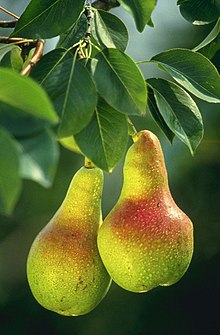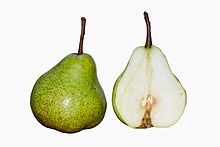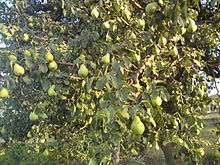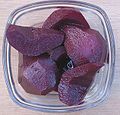Pear
| Pear | |
|---|---|

| |
| European pear branch with two pears | |

| |
| Pear fruit cross section | |
| Scientific classification | |
| Kingdom: | Plantae |
| Clade: | Tracheophytes |
| Clade: | Angiosperms |
| Clade: | Eudicots |
| Clade: | Rosids |
| Order: | Rosales |
| Family: | Rosaceae |
| Subfamily: | Amygdaloideae |
| Tribe: | Maleae |
| Subtribe: | Malinae |
| Genus: | Pyrus L. |
| Species | |
|
About 30 species; see text | |
Pears are fruits produced and consumed around the world, growing on a tree and harvested in late summer into mid-autumn. The pear tree and shrub are a species of genus Pyrus /ˈpaɪrəs/, in the family Rosaceae, bearing the pomaceous fruit of the same name. Several species of pears are valued for their edible fruit and juices, while others are cultivated as trees.
The tree is medium-sized and native to coastal and mildly temperate regions of Europe, North Africa, and Asia. Pear wood is one of the preferred materials in the manufacture of high-quality woodwind instruments and furniture.
About 3,000 known varieties of pears are grown worldwide, which vary in both shape and taste. The fruit is consumed fresh,
Etymology
The word pear is probably from Germanic pera as a loanword of Vulgar Latin pira, the plural of pirum, akin to Greek apios (from Mycenaean ápisos),[1] of Semitic origin (pirâ), meaning "fruit". The adjective pyriform or piriform means pear-shaped.[2] The classical Latin word for a pear tree is pirus;[3] pyrus is an alternate form of this word sometimes used in medieval Latin.[4]
Description
This section needs additional citations for verification. (January 2021) |


The pear is
The leaves are alternately arranged, simple, 2–12 cm (1–4+1⁄2 in) long, glossy green on some species, densely silvery-hairy in some others; leaf shape varies from broad oval to narrow lanceolate. Most pears are deciduous, but one or two species in Southeast Asia are evergreen. Most are cold-hardy, withstanding temperatures as low as −25 to −40 °C (−13 to −40 °F) in winter, except for the evergreen species, which only tolerate temperatures down to about −15 °C (5 °F).
The
The fruit is composed of the receptacle or upper end of the flower stalk (the so-called
Pears and apples cannot always be distinguished by the form of the fruit;
History

Pear cultivation in cool, temperate climates extends to the remotest antiquity, and evidence exists of its use as a food since prehistoric times. Many traces have been found in prehistoric pile dwellings around Lake Zurich. Pears were cultivated in China as early as 2000 BC.[7] An article on Pear tree cultivation in Spain is brought down in Ibn al-'Awwam's 12th-century agricultural work, Book on Agriculture.[8]
The word pear, or its equivalent, occurs in all the Celtic languages, while in Slavic and other dialects, differing appellations, still referring to the same thing, are found—a diversity and multiplicity of nomenclature, which led Alphonse Pyramus de Candolle to infer a very ancient cultivation of the tree from the shores of the Caspian to those of the Atlantic.[citation needed]
The pear was also cultivated by the Romans, who ate the fruits raw or cooked, just like apples.
A certain race of pears, with white down on the undersurface of their leaves, is supposed to have originated from P. nivalis, and their fruit is chiefly used in France in the manufacture of perry (see also cider). Other small-fruited pears, distinguished by their early ripening and apple-like fruit, may be referred to as P. cordata, a species found wild in western France and southwestern England.[citation needed]
The genus is thought to have originated in present-day Western China[12] in the foothills of the Tian Shan, a mountain range of Central Asia, and to have spread to the north and south along mountain chains, evolving into a diverse group of over 20 widely recognized primary species.[citation needed] The enormous number of varieties of the cultivated European pear (Pyrus communis subsp. communis), are without doubt derived from one or two wild subspecies (P. c. subsp. pyraster and P. c. subsp. caucasica), widely distributed throughout Europe, and sometimes forming part of the natural vegetation of the forests. Court accounts of Henry III of England record pears shipped from La Rochelle-Normande and presented to the king by the sheriffs of the City of London. The French names of pears grown in English medieval gardens suggest that their reputation, at the least, was French; a favoured variety in the accounts was named for Saint Rieul of Senlis, Bishop of Senlis in northern France.[13]
Asian species with medium to large edible fruit include P. pyrifolia, P. ussuriensis, P. × bretschneideri, P. × sinkiangensis, and P. pashia. Other small-fruited species are frequently used as rootstocks for the cultivated forms.[citation needed]
Major species

|
Cultivation

According to Pear Bureau Northwest, about 3000 known varieties of pears are grown worldwide.[14] The pear is normally propagated by
Three species account for the vast majority of edible fruit production, the
Other species are used as
Cultivars
The following
- 'Beth'[17]
- 'Beurré Hardy'[18]
- 'Beurré Superfin'[19]
- 'Concorde'[20]
- 'Conference'[21]
- 'Doyenné du Comice'[22]
- 'Joséphine de Malines'[23]
The purely decorative cultivar P. salicifolia 'Pendula', with pendulous branches and silvery leaves, has also won the award.[24]
Harvest
Summer and autumn
Diseases and pests
| Country | (Millions of tonnes) |
|---|---|
| 19.3 | |
| 0.58 | |
| 0.57 | |
| 0.55 | |
| 0.52 | |
| World | 26.3 |
| Source: FAOSTAT[25]
| |
Production
In 2022, world production of pears was 26 million tonnes, led by China with 73% of the total (table). About 48% of the Southern Hemisphere's pears are produced in the Patagonian valley of Río Negro in Argentina.[26]
Storage
Pears may be stored at room temperature until ripe.[27] Pears are ripe when the flesh around the stem gives to gentle pressure.[27] Ripe pears are optimally stored refrigerated, uncovered in a single layer, where they have a shelf life of 2 to 3 days.[27]
Pears ripen at room temperature. Ripening is accelerated by the gas
Uses
Cooking

Pears are consumed fresh, canned, as
Pear purée is used to manufacture snack foods such as Fruit by the Foot and Fruit Roll-Ups.
The culinary or cooking pear is green but dry and hard, and only edible after several hours of cooking. Two Dutch cultivars are Gieser Wildeman (a sweet variety) and Saint Remy (slightly sour).[30]
Timber
Pear wood is one of the preferred materials in the manufacture of high-quality
Nutrition
| Nutritional value per 100 g (3.5 oz) | |
|---|---|
| Energy | 239 kJ (57 kcal) |
15.23 g | |
| Sugars | 9.75 g |
| Dietary fiber | 3.1 g |
0.14 g | |
0.36 g | |
Niacin (B3) | 1% 0.161 mg |
| Pantothenic acid (B5) | 1% 0.049 mg |
| Vitamin B6 | 2% 0.029 mg |
| Folate (B9) | 2% 7 μg |
| Choline | 1% 5.1 mg |
| Vitamin C | 5% 4.3 mg |
| Vitamin E | 1% 0.12 mg |
| Vitamin K | 4% 4.4 μg |
| Minerals | Quantity %DV† |
| Calcium | 1% 9 mg |
| Iron | 1% 0.18 mg |
| Magnesium | 2% 7 mg |
| Manganese | 2% 0.048 mg |
| Phosphorus | 1% 12 mg |
| Potassium | 4% 116 mg |
| Sodium | 0% 1 mg |
| Zinc | 1% 0.1 mg |
| Other constituents | Quantity |
| Water | 84 g |
| †Percentages estimated using US recommendations for adults,[32] except for potassium, which is estimated based on expert recommendation from the National Academies.[33] | |
Raw pear is 84% water, 15%
Research
A 2019 review found preliminary evidence for the potential of pear consumption to affect cardiovascular health.[34]
Cultural references
Pears grow in the sublime orchard of Alcinous, in the Odyssey vii: "Therein grow trees, tall and luxuriant, pears and pomegranates and apple-trees with their bright fruit, and sweet figs, and luxuriant olives. Of these the fruit perishes not nor fails in winter or in summer, but lasts throughout the year."
"A Partridge in a Pear Tree" is the first gift in the cumulative song "The Twelve Days of Christmas".[35]
The pear tree was an object of particular veneration (as was the
Gallery
-
Pears simmered in red wine
-
Pear in a bottle of pear eau de vie
-
Pear blossom in eastern Siberia
See also
References
- ^ Harper, Douglas. "pear". Online Etymology Dictionary.
- ^ "pyriform, adj". Oxford English Dictionary. Oxford University Press. Retrieved 28 April 2021.
- Perseus Project.
- ^ Charles du Fresne, sieur du Cange. "PYRUS". Glossarium Mediae et Infimae Latinitatis. Archived from the original on 15 May 2022 – via Logeion.
- ^ Pear Fruit Facts Page Information. bouquetoffruits.com
- ^ The New Werner Twentieth Century Edition of the Encyclopaedia Britannica: A Standard Work of Reference in Art, Literature, Science, History, Geography, Commerce, Biography, Discovery and Invention. Werner Company. 1907. p. 456.
- ISBN 0415927463.
- –242 (Article XII)
- ISBN 978-1-4443-0514-2.
- ISBN 978-1-903018-13-2.
- OCLC 560560606.
- ISSN 2356-654X.
- ISBN 978-1-4286-3680-4.
- ^ "Pear Varieties". Usapears.com. Archived from the original on 25 June 2014. Retrieved 9 August 2014.
- ISBN 1-85732-905-8, pp100-101.
- ^ "AGM Plants" (PDF).
- ^ "RHS Plant Selector Pyrus communis 'Beth' (D) AGM / RHS Gardening". Apps.rhs.org.uk. Retrieved 17 February 2021.
- ^ "RHS Plantfinder - Pyrus communis 'Beurré Hardy'". Retrieved 23 September 2018.
- ^ "RHS Plantfinder - Pyrus communis 'Beurré Superfin'". Retrieved 23 September 2018.
- ^ "RHS Plant Selector Pyrus communis 'Concorde' PBR (D) AGM / RHS Gardening". Apps.rhs.org.uk. Retrieved 17 February 2021.
- ^ "RHS Plant Selector Pyrus communis 'Conference' (D) AGM / RHS Gardening". Apps.rhs.org.uk. Retrieved 17 February 2021.
- ^ "RHS Plantfinder - Pyrus communis 'Doyenné du Comice'". Retrieved 23 September 2018.
- ^ "RHS Plant Selector Pyrus communis 'Joséphine de Malines' (D) AGM / RHS Gardening". Apps.rhs.org.uk. Retrieved 17 February 2021.
- ^ "RHS Plantfinder - Pyrus salicifolia 'Pendula'". Retrieved 23 September 2018.
- ^ "Production of pears in 2022, Crops/Regions/World Regions/Production Quantity/Year by picklists". UN Food and Agriculture Organization, Statistics Division. 2024. Retrieved 30 March 2024.
- ^ "Las peras de Río Negro convierten al país en el segundo exportador a nivel mundial". Registro Civil (in Spanish). 31 January 2020. Retrieved 29 November 2022.
- ^ a b c Canadian Produce Marketing Association > Home Storage Guide for Fresh Fruits & Vegetables. cpma.ca
- ^ Scott, Judy & Sugar, David (2011). "Pears can be ripened to perfection". extension.oregonstate.edu. Retrieved 30 August 2011.
- ^ "Pear Bureau Northwest". Usapears.org. Archived from the original on 10 May 2013. Retrieved 14 March 2013.
- ISBN 978-90-5972-092-3.
- ^ ISBN 0-941936-20-1.
- ^ United States Food and Drug Administration (2024). "Daily Value on the Nutrition and Supplement Facts Labels". Retrieved 28 March 2024.
- )
- PMID 31667463.
- ^ Bodleian Libraries, University of Oxford. "The twelve days of Christmas". Broadside Ballads Online. Retrieved 4 December 2023.
- ISBN 978-0-415-32328-4.
Further reading
- Joan Morgan (2015). The Book of Pears: The Definitive History and Guide to Over 500 Varieties. Chelsea Green Publishing. ISBN 978-1603586665.




